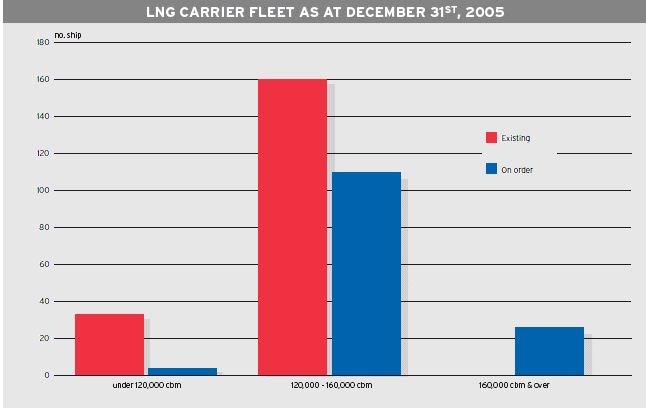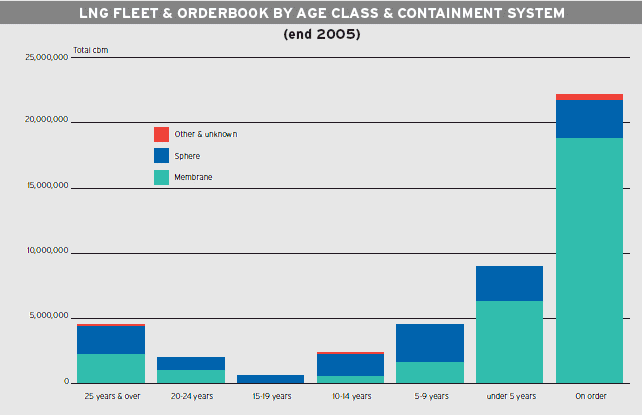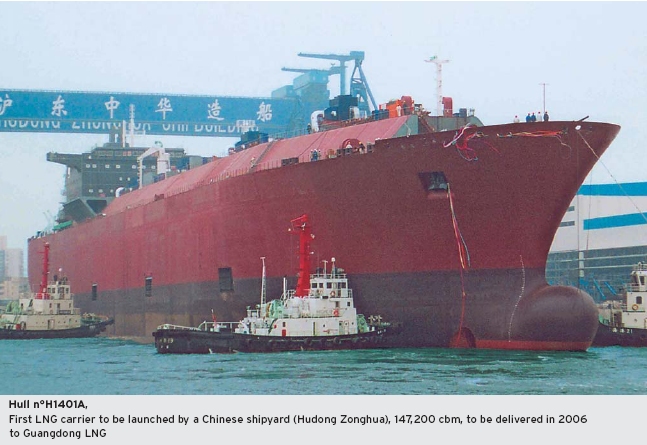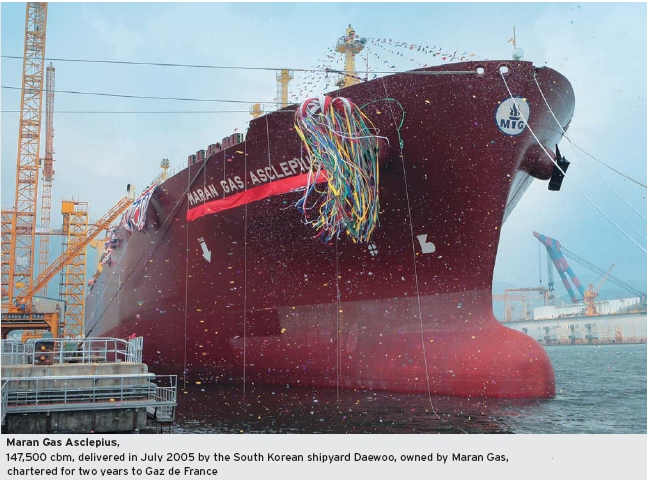
The liquefied natural gas shipping market
in 2005
AN APPRECIATION OF THIS VERY ACTIVE MARKET ALWAYS HAS TO BE PUT INTO PERSPECTIVE, AS IT IS EASY EITHER TO GET FALSE IMPRESSIONS OR ELSE TO STATE THE OBVIOUS.
Moreover, to speak of 'a market' in this sector is almost a misuse of terms, in that total LNG quantities shipped on a spot basis only represent some 10 % of the whole supplies, even though this proportion has substantially increased in the recent years. The fact that the market is still closely linked to projects and to long term supply contracts explains to a large extent the discrepancy between supply and demand. In a nutshell, prospects of growth in demand have led to a rapid increase in the fleet and new orders, but the delays in inaugurating new production trains have brought about a shortage of LNG. Vessels are available, buyers are ready, terminals are operational, but there is simply not enough liquefied gas available, which penalises numerous carriers in the short term. The LNG community expects to see this shortfall last up until 2010.
In addition, the effect of 'projects', with its required transparency, prevents speculative owners from being able to enjoy sufficient returns to offset the lean years at the outset of their ships' existence. The market (which we nevertheless will continue to refer to as such) is therefore somewhat exceptional, with owners in this sector unable to have the same opportunities as owners of other ship types. As the LNG chain remains totally integrated, with the same ships making round-voyages between dedicated loading and discharging terminals, this sector is quite special and it is difficult to speak about a real shipping market.
First of all, let us take a look at the fleet at the end of 2005. Currently there are some 193 ships actively in service, with a total capacity of 23.1 million cbm. The orderbook contains 140 units, totalling 22.1 million cbm, namely practically 100 % of the existing fleet in terms of liquid gas capacity.

Forty-nine ships were ordered in 2005, for 8.5 million cbm, or 37 % of the current fleet, but even more impressive, with an average unit size of over 170,000 cbm! Sixteen ships were delivered in 2005, for 2.3 million cbm, which represents an increase of about 10 % of the fleet.
An historic figure has been attained with these orders: the 200,000 cbm threshold has been surpassed with the order of 20 Q-flex ships of 216,000 cbm, divided between DSME, HHI, and SHI. At the end of the year newbuilding berths have been booked in two South Korean yards for the delivery of 6 Q-max ships of over 260,000 cbm for the Qatari project and for which the choice of owners has yet to be made.
However, the reduced number of orders in 2005, compared to 2004, is significant: whilst there is important potential demand in the long term, only 49 ships were ordered in 2005 as opposed to 75 in 2004. There are several reasons for this:
1- Returns on the long term projects are considered to be too low, and the large number of ships idle at the beginning of the year (which was slightly reduced by the end of the year), has led to short term returns being close to operating costs (around $ 30,000 per day). This context has, also in the short term, pushed the market towards a virtually standard reference price, resulting in identical rates for ships of 140,000 cbm and 70,000 cbm.
2- Delays in the introduction of new terminals.
3- The newbuilding prices have risen during 2005: the price of a gas carrier of 155,000 cbm went from $ 155 million in mid-2004 to $ 185 million by the end of 2005. Thus, what previously could be considered as cheap, and which could be a good bet for the future, is no longer, especially when the number of speculative ships (without employment) has reached such a level (one can count 25 in the orderbooks at the end of 2005). Clearly, this has discouraged owners, who would have liked to participate in this growing market, and it has not incited project operators to place orders too precipitously for new ships which would be unlikely to find employment.
In this context, we have even seen Total hedge their bets for their Yemen project by chartering ships previously ordered speculatively, in order to respect their delivery dates. The risks taken by their owners have been rewarded, but few are likely to be so fortunate amongst the other speculative players.

Some significant aspects concerning the latest orders are to be noted both on the technical and financial side:
Among the 49 orders placed in 2005, only 5 ships will be fitted with the Moss-type containment system, which is leaving a dominant market share to GTT membrane designs, despite the problems encountered by Chantiers de l'Atlantique and Samsung with the secondary membrane, which are in the process of being resolved. This, unfortunately, is the price to be paid for innovative technology.
One has observed an increase in the orders for ships with dual diesel-electric propulsion. This technical aspect risks affecting the future evaluation of steam turbine ships in the second-hand market, since the latter are less efficient.
Finally, the other technical innovation with this year's orders is the introduction of reliquefaction units aboard the Q-flex and Q-max sizes, the first LNG carriers to implement such equipment. On the same ships, a slow-speed diesel engine with twin shaft propulsion has also been chosen, which has previously never been seen on such vessels.
Twenty-one out of the 49 orders last year were for ships over 200,000 cbm, which raises the important question of their financing. Not so long ago one spoke of these sizes without having a clear view of what would be necessary to accommodate them at the terminals. It was therefore difficult to evaluate their real value. The thinking was therefore to say that the value was the value of the charter attached to the ship, but this means that without a charter, it was only worth its scrap value. In a short period of time this approach was superseded and the question of valuation was even reversed. In practice, with the majority of terminals progressively adapting to the bigger sizes, the valuation problem now lies with the numerous ships in service whose sizes are between 130,000 and 155,000 cbm, which are still being built. This problem only affects ships which have been ordered speculatively, since those attached to projects can still be valued with their charters.
2005 was also the year that saw the opening of new sources of finance for LNG shipping, such as the Ger-man KGs. These were notably amongst the first in financing orders for ships over 200,000 cbm.
The club of LNG carrier builders should be joined by a new member this year: the Korean shipyard STX, who is looking to enter this market. Also, the Chinese shipyard Hudong-Zhonghua has launched its first LNG carrier and finished the year with 5 firm orders, whilst three other Chinese shipyards, Dalian, Nacks, and Jiangnan, have been qualified by the Chinese authorities to participate in domestic projects. There was also the comeback of Hanjin to this market. There are now more shipyards able to build LNG carriers than large containerships or stainless steel chemical tankers. This reversal in the shipbuilding sector is also an indication of the growing importance and prestige of LNG carriers in the shipping world.

It should also be noted that 2005 saw the signing of the largest letter of intent ever drawn-up, between Qatar and the three biggest Korean shipyards, for a total of 95 ships to be delivered up until 2012, including contractual clauses fixing renegotiation margins linked to steel price indexes, the exchange rates, and a call off clause.
The commercial situation of the market is that there is still surplus tonnage present from which the LNG sector suffered last year. This, however, has not pushed the owners of older vessels to take the demo option, even though the majority of ships of less than 130,000 cbm are already over 30 years old.
Forecasters, with some justification, claim that the requirements for transparency, which are inherent in the case of projects, lead to fixing rates which are too low to ensure a decent return on investment over the long term, in the region of 6 %, which is not enough for one to feel comfortable with probable increases in operating costs. This might tempt owners to cut back in other areas like maintenance, and could put the very high security levels, which have been practised up until now, in jeopardy. This observation does not take into account the commercial operating life of a gas carrier, which is generally long.
As an example we can quote that a long term charter for a ship valued at $ 220 million only gives a return of between $ 65,000 to $ 75,000 per day.
One also encounters a growing difficulty to recruit qualified LNG crew members, which certainly constitutes one of the reasons why owners have ordered ships with diesel-electric and slow-speed diesel engines. As a consequence, there will be a probable increase in crewing costs over the coming months: there is talk of 10 % in a year's time.
The building costs of LNG carriers, compared to all other types of ships, are those that have increased the least over the last year: only about 14 %. This relatively modest increase is most likely due to the competition between traditional LNG shipyards and newcomers. At the end of 2005, a carrier of 155,000 cbm cost some $ 210 million.

WHERE ARE WE HEADING?
At the moment everything is following the forecasts made two years ago: a situation of overcapacity, which is likely to last for another two to three years. We can expect to hit a peak of something less than 15 % capacity in surplus. This is a straight arithmetical calculation, based on fleet capacity, deliveries, and the number of LNG trains that will come into service.
The LNG map has considerably changed. Sources of supplies, which are becoming more and more predominant, like West Africa, Qatar, and soon Russia, are situated further and further away from the major consuming areas.
New markets are profiling on the horizon: China and India, which are experiencing a rapid growth in demand, and the U.S., which is in the process of depleting its own natural resources. All these factors will displace the centre of gravity for world LNG. We will witness a reorientation of traffic, moving away from the traditional flow of supplies towards the Far-East, coming from South-East Asia.
Regarding the fleet, and concentrating on the most important projects, we should mention Qatar, only half-way through its massive order of ships, and Nigeria which is preparing to announce an order of 60 ships in the coming months.
Identified projects add up to additional shipping requirements of 115 carriers until 2010, and to 200 for 2015, in addition to the current orderbook.
Beyond the two to three years of foreseeable surplus tonnage, there is a whole new chapter to be written. It will be necessary to raise no less than $ 23 billion until 2010 to finance these new ships, without counting the corollary needs in the building and restructuring of terminals.
If one approaches the problem on the basis of the LNG chain and the ship linked to its terminals, the total financing needs from now until 2015 is about $ 100 billion (in the global chain, a ship represents about 40 % of financing needs.) Given the ratios applied by the banks, this will require new sources of financing.
There is a need for a closer analysis of shipyards. In practice, the compensated gross tons (the unit to evaluate shipyards' work) for building a LNG carrier equates to 2.5 VLCCs, which means that shipyards which use their workforce to build LNG carriers will operate a building capacity equivalent to that of 500 VLCCs over the same period.
This could be the answer to the question raised on the forecasted drop in demand for large containerships, which might then cause a standstill in newbuilding capacity and cause prices to plunge. Thus, if all goes well in the LNG scenario mentioned above, the risk of seeing surplus building capacity over the period considered is limited.
Another theory is put forward, in which the multitude of terminals, ships and players should result in a multiplicity of routes and thus an increase in the level of the 'necessary disorder' to create a 'real' market. It is the hallmark of LNG not to resemble oil, and we have seen that with the majority of carriers dedicated to projects for which they were financed, there is still no real market and not enough unemployed LNG ships in this sector to be considered a 'shipping market' in its own right.
A final matter of consideration concerns the technology. If, in fact, installations with re-liquefaction plants simultaneous to discharging develop, should one expect a rush towards the order of ships equipped with this re-liquefaction systems? If so, what will happen to the second-hand value of speculative ships that were ordered before, which are not equipped with such devices?
Indubitably, this rather unique sector holds a whole range of possible avenues'
Shipping and Shipbuilding Markets in 2005
I N D E X